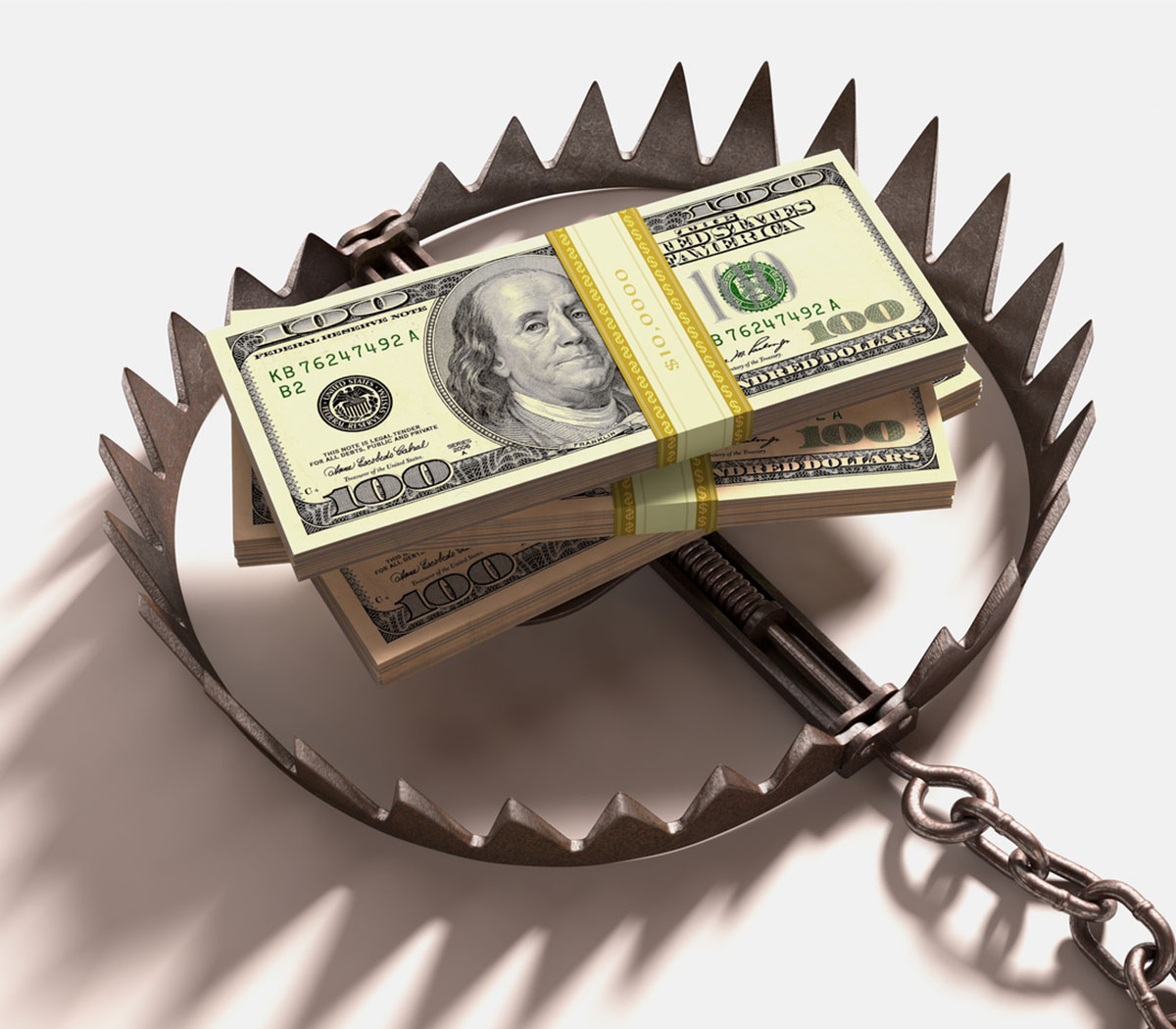

Finance
What Does A Bear Trap Mean In Stock Market
Published: October 20, 2023
Discover the meaning of a bear trap in the stock market and its implications for investors. Stay informed about finance and make informed decisions.
(Many of the links in this article redirect to a specific reviewed product. Your purchase of these products through affiliate links helps to generate commission for LiveWell, at no extra cost. Learn more)
Table of Contents
Introduction
Welcome to the world of finance, where the stock market can be both thrilling and perilous. As an investor, it is crucial to navigate the market with a keen eye and a deep understanding of its various dynamics. One such phenomenon that can catch investors off guard is a bear trap.
In the stock market, a bear trap refers to a situation where prices appear to be in a downward trend, leading investors to believe that the market is entering a bearish phase. However, this turns out to be a deceptive move, as the prices reverse course and start to rise again, trapping those who had taken short positions or sold their assets in anticipation of a bearish market.
The concept of a bear trap can be quite fascinating, as it involves psychology, market manipulation, and timing. It is important for traders and investors to be aware of the characteristics, signs, and implications of a bear trap in order to avoid falling into this trap and suffering significant losses.
In this article, we will delve deeper into the definition of a bear trap, its characteristics, how it works, and the potential outcomes for investors. We will also explore examples of bear traps in the stock market and discuss strategies to avoid or navigate this treacherous situation.
So, let’s strap ourselves in and explore the intriguing world of bear traps in the stock market.
Definition of a Bear Trap in the Stock Market
Before we dive into the intricacies of a bear trap, let’s establish a clear understanding of what it actually means in the context of the stock market.
A bear trap is a term used to describe a scenario in which the price of a stock or an entire market appears to be entering a bearish trend, causing investors to believe that prices will continue to fall. This perception attracts traders who take short positions or sell their holdings in anticipation of further price declines.
However, just as these investors position themselves for profit, the market unexpectedly reverses course, catching them off guard. The price starts to rise instead of continuing to fall, trapping those who had bet against it. This sudden surge in price leads to losses for those who were caught in the bear trap, hence the term “bear trap.”
It is important to note that a bear trap can occur at various scales, ranging from individual stocks to entire markets. In either case, the trap occurs when the prevailing sentiment suggests a downward trend, luring investors into pessimistic positions.
While a bear trap is often associated with temporary false signals in a bearish market, it can also occur within larger bearish trends. This deceptive move can create opportunities for traders who can accurately identify and capitalize on these traps.
Now that we have defined what a bear trap is in the stock market, let’s explore its key characteristics to gain a deeper understanding of this phenomenon.
Characteristics of a Bear Trap
To recognize and analyze a bear trap, it is essential to understand its key characteristics. By identifying these traits, investors can better anticipate and navigate potential bear traps in the stock market. Here are some notable characteristics:
- Deceptive Price Decline: One of the primary features of a bear trap is a sudden and convincing decline in prices. This decline can give the impression that the market is entering a bearish phase. It may be driven by negative news, market sentiment, or technical indicators, leading investors to anticipate further price drops.
- Increased Selling Pressure: As prices fall, there is often an increase in selling pressure, as investors rush to sell their holdings to avoid potential losses. This selling pressure creates a negative feedback loop, reinforcing the perception of a bearish trend.
- Traders Betting Against the Market: During a bearish market, traders may take short positions or sell their assets, expecting prices to continue declining. These traders believe they are taking advantage of the downward trend and aim to profit from further price drops.
- Sudden Reversal: The defining characteristic of a bear trap is the unexpected reversal in price direction. Instead of continuing to fall, the market reverses course and starts to rise, catching traders off guard. This reversal can be triggered by positive news, market manipulation, or a shift in investor sentiment.
- Losses for Traders Caught in the Trap: As the market reverses, traders who took short positions or sold their assets find themselves on the wrong side of the trade. They may incur significant losses as they scramble to exit their positions or cover their short positions at higher prices.
These characteristics highlight the deceptive nature of a bear trap. The market creates an illusion of a bearish trend, luring traders and investors into negative positions, only to reverse unexpectedly and cause losses for those caught in the trap.
Now that we have explored the characteristics of a bear trap, let’s delve into how exactly a bear trap works and the underlying mechanics behind it.
How a Bear Trap Works
Understanding the mechanics of how a bear trap works can provide valuable insights into its dynamics and help investors navigate potential traps in the stock market.
The workings of a bear trap can be summarized in three key stages:
- Stage 1: Initial Decline
- Stage 2: Accumulation and Manipulation
- Stage 3: Reversal and Trapped Investors
In this stage, the market experiences a convincing decline in prices, often due to negative news, economic indicators, or technical factors. This decline creates a sense of fear and pessimism among investors, who anticipate further price drops. Traders and investors who believe in the continuing downtrend may take short positions or sell their holdings in anticipation of profiting from the bearish market.
During this stage, the market undergoes a period of accumulation, in which savvy investors and market participants strategically accumulate shares or assets of the security or market that is falling. By doing so, they create a false impression that the downtrend is continuing. Market manipulation, such as spreading negative rumors or engaging in coordinated selling, can further contribute to this deception.
The final stage of a bear trap is the sudden reversal. Prices unexpectedly start to rise, catching traders and investors who had taken short positions or sold their assets in a bearish anticipation. As the market reverses, sell orders are overwhelmed by new buy orders, leading to a rapid increase in prices. Traders caught in the trap are left scrambling to cover their short positions or exit their negative positions, often incurring significant losses.
The mechanics of a bear trap rely on psychological factors, market manipulation, and the element of surprise. The initial decline and negative sentiment create a convincing illusion that the market is entering a bearish phase. This encourages traders to bet against the market, only to be trapped when the prices reverse unexpectedly.
It is important to note that bear traps can be intentionally orchestrated by market participants with significant influence or by institutional investors. These market players have the means and resources to create a false perception and exploit the resulting price movements.
Now that we understand how a bear trap works, let’s move on to the signs that can help investors identify a potential bear trap in the stock market.
Signs of a Bear Trap
In order to avoid falling into a bear trap in the stock market, it is crucial to be able to recognize the signs that may indicate the presence of such a trap. Here are some common signs to watch out for:
- False Breakdown: One of the key signs of a potential bear trap is a false breakdown in price. This occurs when a stock or market briefly drops below a significant support level or breaks a major trendline, only to quickly reverse and move back above. This sudden reversal can indicate that the bearish move was temporary rather than a sustained trend.
- Low Trading Volume: Another sign to watch for is unusually low trading volume during the initial decline. If the decline in prices is accompanied by low trading activity, it may suggest a lack of conviction among the selling traders. This could be an indication that the decline is not as significant as it appears and that a bear trap might be in play.
- Positive Divergence: A positive divergence in technical indicators can serve as a signal for a potential bear trap. This occurs when the price of a stock or market continues to decline, but the indicators such as the Relative Strength Index (RSI) or Moving Average Convergence Divergence (MACD) show higher lows or a bullish divergence. This suggests that underlying buying pressure may be building, potentially leading to a reversal in price direction.
- Unexpected Positive News: If there is a sudden influx of positive news amidst a declining market, it may raise suspicions of a potential bear trap. This could be a company’s better-than-expected earnings announcement, a positive economic report, or a government intervention to support the market. These unexpected positive events can create a reversal in sentiment and lead to a bear trap.
- Abnormal Price Movements: Pay close attention to any abnormal price movements, especially sudden spikes or sharp reversals. If the market shows drastic and rapid reversals from the prevailing downtrend, it could be an indication of a bear trap. This dramatic change in price direction can catch short-sellers off guard and result in a rapid rise in prices.
It is important to note that while these signs may point to the possibility of a bear trap, they are not foolproof indicators. The market is unpredictable, and false signals can occur. Therefore, it is advisable to use these signs as a guide and combine them with thorough analysis and market research to make informed investment decisions.
Now that we have discussed the signs of a bear trap, let’s examine real-world examples to gain a better understanding of how bear traps have played out in the stock market.
Examples of Bear Traps in the Stock Market
To fully grasp the impact and implications of bear traps in the stock market, let’s explore some notable examples that have occurred in the past:
- Flash Crash of 2010: On May 6, 2010, the U.S. stock market experienced a sudden and severe decline, commonly known as the “Flash Crash.” The Dow Jones Industrial Average plunged nearly 1,000 points within minutes before quickly rebounding. This sharp decline trapped many traders who had placed automatic sell orders or stop-loss orders, resulting in significant losses. Investigations revealed that the flash crash was triggered by a combination of high-frequency trading algorithms and a lack of liquidity.
- Brexit Vote in 2016: Following the United Kingdom’s referendum on European Union membership on June 23, 2016, the stock market experienced significant volatility and uncertainty. In the immediate aftermath of the referendum results, global markets initially plunged, as investors anticipated a bear market. However, within days, most of the losses were recouped, and the markets rebounded. Those who had taken short positions or sold their assets in anticipation of a prolonged bearish market were caught in a bear trap as the market swiftly reversed its course.
- Bitcoin Bull Trap of 2018: In late 2017, Bitcoin reached its all-time high, generating a lot of hype and attracting a surge of investors. However, in early 2018, Bitcoin and other cryptocurrencies experienced a significant price decline. Many investors believed that the bearish trend was here to stay and took short positions or sold their holdings. Unfortunately, the market staged a short-lived recovery, causing losses for those who were caught in the bear trap.
- COVID-19 Stock Market Crash: In early 2020, as the COVID-19 pandemic spread globally, stock markets experienced a severe crash. Investors anticipated a prolonged bear market due to the economic uncertainties brought on by the pandemic. However, central bank interventions, government stimulus packages, and positive vaccine news led to a rapid market recovery, trapping traders who had bet against the market and causing significant losses for those caught in the bear trap.
These examples highlight how bear traps can occur during times of heightened market volatility and uncertainty. They serve as reminders that even in the face of pessimism and significant price declines, the market can quickly and unpredictably reverse its course, trapping those who have bet against it.
Now that we have seen real-life examples of bear traps, let’s explore the risks and implications that falling into a bear trap can have on investors.
Risks and Implications of Falling into a Bear Trap
Falling into a bear trap can have significant risks and implications for investors. Here are some of the key risks and potential consequences of being caught in a bear trap:
- Financial Losses: The most immediate and obvious risk of falling into a bear trap is financial losses. Traders and investors who have taken short positions or sold their assets in anticipation of a bearish market may face substantial losses as the market reverses and prices start to rise. This can have a significant impact on their investment portfolio and overall financial well-being.
- Emotional Impact: Falling into a bear trap can also have a psychological and emotional impact on investors. It can lead to feelings of frustration, anxiety, and regret, especially if they sold their holdings at lower prices and missed out on potential profits when the market rebounded. Such emotional turmoil can affect decision-making and lead to further unfavorable investment choices.
- Opportunity Cost: Being trapped in a bear market can also result in missed investment opportunities. While investors are stuck in a losing position, the broader market may experience a significant rally, resulting in missed gains. This opportunity cost can have long-term implications on an investor’s wealth accumulation and overall investment performance.
- Loss of Confidence: Falling into a bear trap can dent an investor’s confidence and trust in their own decision-making abilities. It can erode their faith in the market’s predictability and make them hesitant to take future investment risks. This loss of confidence can hinder their ability to make sound investment decisions and potentially impede future investment success.
- Negative Impact on Investment Portfolio: The losses incurred from falling into a bear trap can have a negative impact on an investor’s overall investment portfolio. It can lower the portfolio’s value, leading to a decrease in net worth. This negative impact may require reassessment of investment goals and strategies, potentially causing delays in achieving financial objectives.
It is important for investors to recognize and understand the risks associated with falling into a bear trap. By being aware of these potential implications, investors can take steps to minimize their exposure to such traps and effectively manage the risks involved in their investment decisions.
Now that we have explored the risks and implications of falling into a bear trap, let’s discuss some strategies to avoid or navigate this treacherous situation.
Strategies to Avoid or Navigate a Bear Trap
Navigating or avoiding a bear trap in the stock market requires a combination of vigilance, research, and strategic decision-making. Here are some effective strategies to help investors minimize the likelihood of falling into a bear trap:
- Thorough Research and Analysis: Conduct thorough research and analysis before making any investment decisions. This includes evaluating the fundamentals of the company or market, analyzing technical indicators, studying market trends, and keeping abreast of relevant news and events. A deep understanding of the investment landscape can help identify potential bear traps and make informed decisions.
- Practice Risk Management: Implement robust risk management techniques to protect your investments. Set stop-loss orders, diversify your portfolio across different asset classes and sectors, and avoid overexposure to any single investment. By spreading your risk and setting clear exit strategies, you can mitigate the impact of unexpected market reversals.
- Stay Objective: Emotions can cloud judgment, especially during periods of market volatility. It is important to stay objective and avoid making impulsive investment decisions based on fear or greed. Stick to your investment strategy and resist the urge to react to short-term market movements.
- Pay Attention to Volume and Market Sentiment: Monitor trading volume and market sentiment for potential signs of a bear trap. Unusually low trading volume during a price decline or a shift in sentiment from extreme bearishness to optimism may signal a reversal in price direction. Combined with other technical and fundamental analysis, these indicators can provide valuable insights.
- Be Cautious of Market Manipulation: Be wary of market manipulation techniques that can create false bearish trends. Stay informed about market rumors, coordinated selling, or other manipulative tactics that could deceive investors. Being aware of these tactics can help you avoid falling into a bear trap orchestrated by influential market participants.
- Seek Professional Advice: Consider seeking guidance from financial advisors or professionals who have experience navigating the complexities of the stock market. They can provide valuable insights and help you make informed decisions based on your specific financial goals and risk tolerance.
By implementing these strategies, investors can minimize the risks associated with bear traps and improve their ability to navigate through challenging market conditions. However, it is essential to remember that even with the best strategies, investing inherently carries risks, and there is no foolproof method to completely avoid market downturns.
Now that we have discussed strategies to avoid or navigate a bear trap, let’s conclude our exploration of this intriguing phenomenon in the stock market.
Conclusion
Bear traps can be treacherous and unexpected obstacles in the stock market, catching traders and investors off guard. Understanding the definition, characteristics, mechanics, and implications of bear traps is essential for navigating the complexities of the financial markets.
In this article, we explored the definition of a bear trap as a deceptive move in which prices initially appear to be entering a bearish trend before reversing unexpectedly. We discussed the characteristics of a bear trap, such as a deceptive price decline, increased selling pressure, and the sudden reversal that traps investors.
We also highlighted the signs that can indicate the presence of a bear trap, including false breakdowns, low trading volume, positive divergences, unexpected positive news, and abnormal price movements.
Examining real-world examples, such as the Flash Crash of 2010 and the COVID-19 stock market crash, helped illustrate the potential impact of falling into a bear trap. We discussed the risks and implications, including financial losses, emotional impact, missed opportunities, loss of confidence, and negative impacts on investment portfolios.
To navigate or avoid bear traps, we suggested strategies such as thorough research and analysis, practicing risk management techniques, staying objective, paying attention to volume and market sentiment, being cautious of market manipulation, and seeking professional advice.
While these strategies can help investors minimize the risks, it is important to remember that the stock market is inherently unpredictable, and there are no foolproof methods to completely avoid bear traps or market downturns.
By staying vigilant, conducting thorough research, and making informed decisions, investors can enhance their ability to navigate the complexities of the stock market and potentially avoid the pitfalls of bear traps.
Now armed with knowledge about bear traps, you can approach the market with a deeper understanding and make more informed investment decisions.














